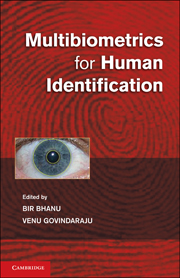Book contents
- Frontmatter
- Contents
- List of Contributors
- Preface
- Introduction
- PART I MULTIMODAL AND MULTISENSOR BIOMETRIC SYSTEMS
- PART II FUSION METHODS IN MULTIBIOMETRIC SYSTEMS
- PART III HYBRID BIOMETRIC SYSTEMS
- PART IV DATABASES AND SECURITY
- 12 Acquisition and Analysis of a Dataset Comprising Gait, Ear, and Semantic Data
- 13 Dynamic Security Management in Multibiometrics
- PART V PERFORMANCE OF MULTIBIOMETRIC SYSTEMS
- Plate section
13 - Dynamic Security Management in Multibiometrics
from PART IV - DATABASES AND SECURITY
Published online by Cambridge University Press: 25 October 2011
- Frontmatter
- Contents
- List of Contributors
- Preface
- Introduction
- PART I MULTIMODAL AND MULTISENSOR BIOMETRIC SYSTEMS
- PART II FUSION METHODS IN MULTIBIOMETRIC SYSTEMS
- PART III HYBRID BIOMETRIC SYSTEMS
- PART IV DATABASES AND SECURITY
- 12 Acquisition and Analysis of a Dataset Comprising Gait, Ear, and Semantic Data
- 13 Dynamic Security Management in Multibiometrics
- PART V PERFORMANCE OF MULTIBIOMETRIC SYSTEMS
- Plate section
Summary
Introduction
Biometrics-based personal identification systems offer automated or semiautomated solutions to various aspects of security management problems. These systems ensure controlled access to the protected resources and provide higher security and convenience to the users. The security of the protected resources and information can be further enhanced with the usage of multibiometrics systems. The multibiometric systems are known to offer enhanced security and antispoofing capabilities while achieving higher performance. These systems can utilize multiple biometric modalities, multiple biometric samples, multiple classifiers, multiple features, and/or normalization schemes to achieve performance improvement (refer to chapter x for more details). However, the higher security and reliability offered by multibiometrics systems often come with additional computational requirements and user inconvenience, which can include privacy and hygienic concerns. Therefore the deployment of multibiometrics systems for civilian and commercial applications is often a judicious compromise between these conflicting requirements. The management of multibiometric systems to adaptively ensure the varying level of security requirements, user convenience, and constraints has invited very little attention in the literature. Very little work has been done on the theory, architecture, implementation, or performance estimation of multibiometrics that dynamically ensure the varying level of security requirements.
Why Dynamic Security Management?
The expected security requirements from the multibiometrics systems are typically expressed in terms of error rates and reliability of the employed system.
These error rates correspond to false acceptance rate (FAR), which is the rate at which imposters are accepted as genuine users, or false rejection rate (FRR), which is the rate at which genuine users are rejected by the system as imposters.
- Type
- Chapter
- Information
- Multibiometrics for Human Identification , pp. 302 - 320Publisher: Cambridge University PressPrint publication year: 2011

